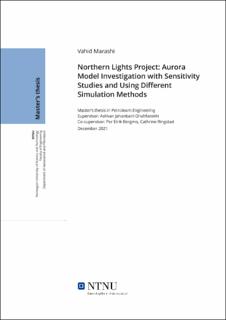| dc.description.abstract | The Norwegian "Longship" full-scale carbon capture and storage (CCS) project was defined over the Norwegian Continental Shelf (NCS) following the successful Sleipner CO2 storage operation. The Northern Lights project is part of the Longship project, responsible for transporting CO2 captured from industrial sources via ship and pipeline and storing the captured CO2 in the subsurface. The Aurora complex, southwest of Troll Field, has been identified as a storage site for this purpose. This storage site comprises two sandstone formations that have been treated as one saline aquifer with promising storage capacity for long-term CO2 storage.
Numerical reservoir simulations can be very useful for CO2 sequestration projects since they provide a great deal of information about the best storage sites for optimal injection strategies by simulating the physics of the rock/fluid inside the formation and forecasting the possible CO2 distribution along with the formation before an expensive injection operation. It is feasible to utilize Schlumberger's ECLIPSE software to adapt the black-oil model for CO2 storage (ECLIPSE 100) and the CO2STORE module in compositional modeling (ECLIPSE 300). Additionally, sensitivity studies must be carried out to assess the impact of uncertain parameters on pressure changes, the amount of CO2 dissolved in the brine phase, and the likely distribution pathway of injected CO2 in the reservoir over a long period.
The given Aurora model was initially refined and updated in this project to create a new base case model. The Aurora model (black-oil) was then converted to a compositional model using the CO2STORE option, employing the equation of state and solubility models to assess the quantity of dissolved CO2 in the brine phase over time. CO2STORE module uses dedicated storage output parameters for mobile, immobile, and dissolved CO2, whereas the black-oil model does not. According to the results, the differences in computations between these two simulation methods were minor. The black-oil simulation is a wiser choice for sensitivity studies with several simulations needed due to their low computation time, while the compositional simulation is more suitable for achieving more accurate results. In addition, a sensitivity analysis was carried out to account for the uncertainty of six reservoir parameters. According to the findings, pore volume and rock compressibility have the most impact on pressure build-up and stabilization, while permeability ratio, fault transmissibility, and relative permeability curve have the greatest influence on CO2 plume distribution over the reservoir. | |
